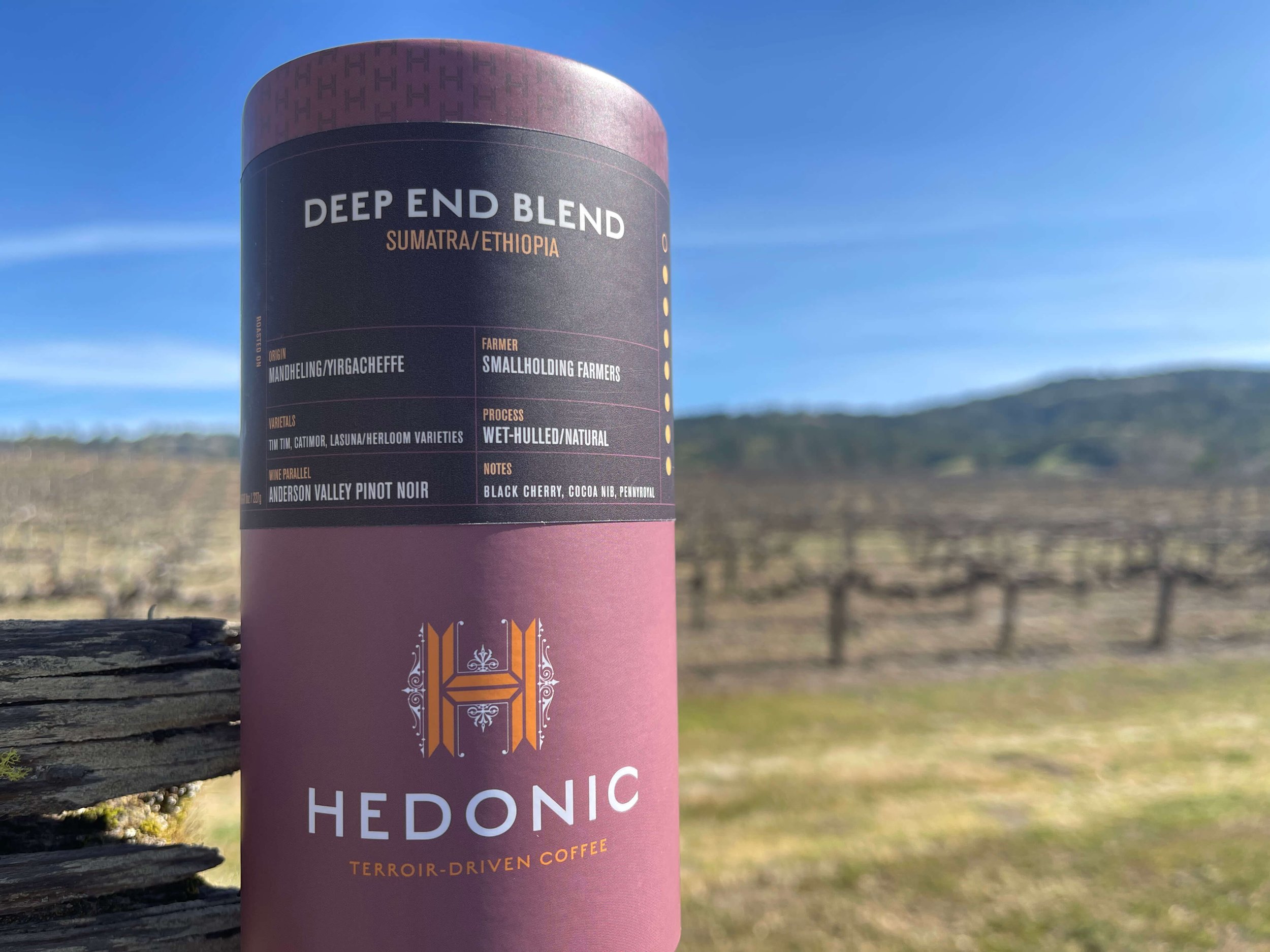How Sommelier Kim Westerman is Crafting Hedonic: The Coffee for Wine Lovers
Editor’s note: We tapped Kim Westerman to write about Tommy Tardie’s The Morning Dram a coffee aged in bourbon barrels. Today we focus on her coffee brand and its roots in wine.
For Hedonic’s Kim Westerman, the transition from wine to coffee was unplanned, but not surprising. “For even the casual wine drinker, ‘terroir’ is now a household word,” she says. “And the same concept of terroir—the idea that wine is a product of the holistic environment in which it was made—applies to coffee.”
Westerman had been a freelance wine and travel writer with sommelier credentials before she took a copyediting gig at Coffee Review, which would turn out to be the pivot toward founding Hedonic, her own terroir-driven coffee brand. Similar in style to Wine Spectator in that it offers reviews and ratings of coffee for consumers on a 100-point scale, it was in the Coffee Review lab there where Westerman discovered that her sensory capabilities translated extremely well from grapes to beans, and she was trained to “cup” coffee. “Cupping is a method of sensory analysis, much like wine tasting—there’s lots of slurping and spitting—that allows us to identify and evaluate a coffee’s aroma, acidity, body and flavor,” says Westerman, “and within a year, I had earned my Q-grader certification,” the coffee equivalent of sommelier, without the guest-facing component.
It was also at the cupping table where Westerman made the connection with actual flavor similarities between wine and coffee, in what she describes as a visceral, almost Proustian moment. “The first time this lightbulb went off in my brain was when I made the connection between a beautiful, complex Sumatra coffee and the funky, earthy herbaceousness of a Cabernet Franc, specifically a Bourgueil,” she says, and she was transported back to Sardinia, where Cab Franc also grows, taking in the smell of the sweet herbs growing on the sun-baked hillsides.
Coffee Terroir
It was this lightning bolt connection between wine and coffee that eventually influenced the ethos of Hedonic as terroir-driven coffee. “While there’s been little scientific study of coffee terroir, the anecdotal evidence—really, the lived experience of coffee farmers all over the world—is clear that the same variety of Arabica grown in Kenya will taste different grown in Kona,” says Westerman. And, exactly like wine grape terroir, “these nuances can be linked to soil types, agricultural practices, altitude, weather, longitude and latitude, and yes, even slope and direction of the sun.”
Similarly, just as winemakers can influence the outcome of the wine by decisions made before and after harvest, coffee beans can produce different outcomes depending on choices made by the processors, especially when it comes to fermenting pulped coffee fruit, or drying whole fruit in the sun before pulping. Coffee processing also often utilizes actual winemaking practices, explains Westerman: “Carbonic maceration and the addition of wine yeasts are two of the most common coffee processing techniques, and they come directly from what we know about winemaking.”
Selling Coffee to Wine Lovers
Wine lovers are a natural fit for coffee appreciation, according to Westerman, regarding the explicit decision to tag Hedonic as “Coffee for Wine Lovers.” “Serious wine drinkers are people who are already poised to experience and reflect on the complexity of what they’re drinking, maybe even approach it as a meditation,” she says. “Some people get it right away, but most are really surprised to make the connection. Wine drinkers are usually very interested in the idea, and curious to learn more.”
Working With Wineries
The parallels that Westerman draws between wine and coffee don’t stop with just tasting notes or marketing techniques, however. The Hedonic lineup actually includes numerous blends that are collaborative efforts with various wineries. Such coffees include Eventide—Abbot’s Passage Signature Coffee and Theorem Vineyards Voir Dire.
“I partner with wineries interested in collaborating on parallels between specific wines or broader AVAs,” says Westerman. “If I’m less familiar with a region, I’ll start by tasting a bunch of wines and generating aroma and flavor descriptors, then narrow down coffees that might exhibit similar qualities. It’s an elaborate process but a satisfying one.”
In near future projects, Westerman is currently working on a coffee parallel for Stag’s Leap AVA. She was also approached by Napa’s Anarchist Wine Co./Foundry not only for a coffee blend to parallel one of their wines, but for an educational collaboration: “They approached me about joining a panel for media about the parallels between wine and coffee blending, and we'll be tasting three coffees that offer a wide range of sensory experiences. I'll be in conversation with their wine educator, Stuart Ake, and their winemaker, Patrick Saboe,” she says, adding, “it's been terrific to find winemaking partners who are eager to explore the many parallels between wine and coffee. Some people really get it!”
Coffee and Hedonism
Speaking of satisfaction, given the name, it’s also clear that Hedonic’s and Westerman’s sensory point of view is rooted not only in terroir, but in pleasure. It’s worth mentioning that the coffee canisters themselves rate as hedonistic in my book, and are among the most gorgeous coffee packages I’ve seen: sleek cylinders that are themselves reminiscent of wine bottles, containing whole beans bagged with a metal clip.
“Hedonism is the idea that pleasure is an appropriate aim of human existence; it’s the opposite of suffering,” says Westerman. “We can all identify with this desire, and it doesn’t have to be—in fact, it shouldn’t be—exclusive. We can access it on a walk in the woods, in awe of an unparalleled view, and in the simple act of enjoying a cup of coffee or a glass of wine.”




